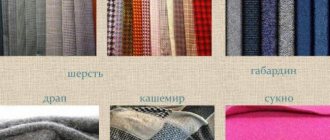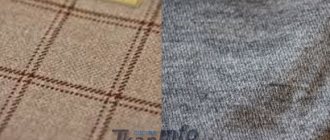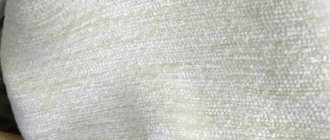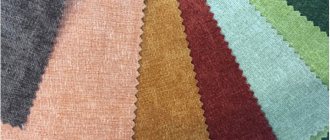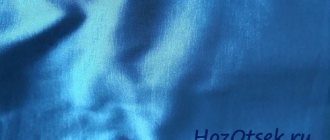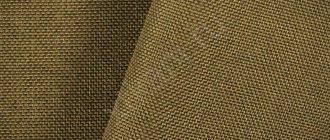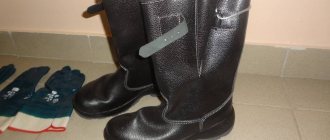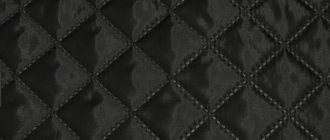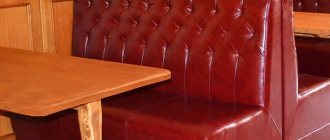Wool fabric is a textile fabric made from the hair of various animals. Wool is one of the most valuable and unique materials in its properties. Handicraft production of woolen cloth originated in the cities of the Ancient East, and the first mentions of it in Rus' date back to the 10th century.
The heyday of crafts and trade in this area occurred in the Middle Ages. France, England, Saxony, Florence and some other lands were famous for their wool fabrics, which could compete even with silk in the market. In the 18th century, machine production opened up new possibilities for processing wool. Mountainous countries have an advantage in production: for example, Italian fabric is famous for its quality.
Types of wool fabrics
Wool can be natural - sheared or combed from animals, factory - removed from skins (less durable) and regenerated - obtained from finished wool products. The most common types of woolen fabric are flannel, felt, velor, cashmere, gabardine, cloth, flannel, grosgrain, drape, etc.
Drape fabrics
Felt fabric
Cloth fabric
Merino and camel wool, cashmere, alpaca, angora, and mohair are used to make fabrics. The most common items are made from sheep wool of various breeds. The types of wool products are very diverse. An item of clothing, an accessory or wool curtains - the uniqueness of the material allows it to be used in completely different areas. Wool properties:
- high heat-shielding properties;
- low heat resistance;
- good hygroscopicity;
- elasticity;
- strength;
- durability;
- hypoallergenic;
- accumulation of static electricity;
- demand for care.
The entire range of woolen fabrics is usually divided into 2 main groups: woolen and wool blends. The composition of 80% wool blend threads can include both natural and synthetic additional fibers. Wool blend fabrics are often multi-component, containing different types of fibers. The addition of cotton threads reduces the cost of the product, but at the same time the appearance of the product becomes noticeably worse, and shrinkage and creasing noticeably increase. Nylon increases the mechanical properties of the fabric, but when added above 10% it makes it quite rigid.
You may also be interested in: Crepe fabric for curtains - its types and properties
Polyester fibers achieve the same effect, maintaining the softness of the fabric, but at the same time reducing hygroscopicity and increasing the tendency for pilling. Acrylic looks very much like wool, but reduces strength, so to compensate for wear resistance, manufacturers add nylon threads. Fabrics with viscose make quite strong, inexpensive and noble-looking things. Viscose transforms coarse material, making it softer and more flexible, but thin material, on the contrary, becomes worse in quality. One of the most expensive combinations is wool and silk fabric.
How to determine the naturalness of wool
Three simple ways:
- Take a piece of thread and set it on fire. Natural fiber flares up quickly and burns slowly. When it goes out, the smell of burnt hair will be felt, and the burnt thread is easily ground into dust. Material containing artificial fibers will leave behind a polymer droplet.
- You need to wrinkle a piece of fabric and listen to your feelings. The synthetic fiber slides and makes a grinding sound, which can even give you unpleasant goosebumps. During the process, static electricity appears and a cracking sound is heard. Small flashes are visible in the darkness. If you knead the natural fabric, the skin will only tingle a little.
- Take a close look at the yarn. Real wool is branched and has an uneven structure. Artificial textiles or those with impurities look smoother, and the finest hairs do not stick out. Therefore, synthetic material is not so prickly and softer than natural material.
The label must indicate the composition. If an item is made of expensive material, for example, angora or cashmere, you should ask for a certificate for the item before purchasing.
Types of wool fabrics
Depending on the type of yarn used for the manufacture of textile material, 3 types can be distinguished:
- Worsted (combed differently) fabrics - they have a smooth front side and a clearly defined weave of threads. They are made from combed yarn, twisted in 2 folds, which increases strength and keeps the shape of the finished product well. A wide range of weaves is used in production: small- or large-patterned, plain, twill and combined. And depending on the ratio of the number of vertical and horizontal threads, dense woolen fabric receives a greater or lesser degree of softness.
- Fine cloth fabrics are made from hardware yarn, most often dyed. The composition can include both natural wool and regenerated wool, and reverse wool, and combed tow. The fabric becomes softer and warmer than worsted. Most fine-woven fabrics have a small pile. It is obtained as a result of felling, or backcombing if the fabric is piled. Woolen fleecy fabric has a variety of weaves, just like seditious fabrics.
- Coarse cloth fabrics are produced using a hardware method from coarser and thicker fibers, due to which they are tough and prickly. Intensive rolling during finishing makes the fabric quite thick and heavy and, as a result, poorly draped. Coarse wool fabric has low ductility and shrinkage, as well as good wind and heat protection properties.
It will also be interesting: Velvet - what kind of fabric, types of velvet and use in the interior
Features of the material and production technology
Wool is a type of fabric made by using raw materials that humans obtain from animals of different species. Most often, the “suppliers” are the following animals:
- sheep (lambs);
- merino;
- sheep (Shetland);
- Cheviot;
- goats (cashmere, angora);
- rabbits (Angora);
- camels;
- vigogne;
- alpaca.
Processing different types of wool
The process of making wool includes the stages of preparation and weaving:
- Rewinding wool threads onto bobbins and removing foreign substances.
- Impregnation with softening, adhesive substances (sizing, felting).
- Threading the warp threads, distribution between the teeth.
- Moisturizing, rewinding weft threads.
- Finishing of fabric (dying, filing to give relief, welding to give uniformity, washing to remove impurities and carbonization, rolling, napping, bleaching, decating (wet), drying, cutting, cleaning, finishing by heating with steam and cooling).
For your information! Some elements of the finishing stage are missing, since not all types of wool need to be bleached or brushed.
To reduce the cost of certain types of raw materials, cotton, acrylic, silk, viscose or polyester fibers are added to wool. This allows you to give the fabric strength, durability, and wear resistance.
In some cases, the answer to what wool is made from involves Lycra. A small amount is added to the fabric to increase stretchability. In this case, the material becomes stretch and lycra is added to the description. Also, for greater elasticity, nylon is added to wool. Often the ratio of synthetic threads and wool in the fabric is 70/30.
Sweater
Wool products
A wide variety of men's, women's, and children's clothes for the cold season are sewn from wool:
- sweaters;
- dresses;
- costumes;
- coat;
- trousers;
- skirts;
- jackets;
- hats, scarves;
- mittens, gloves.
In addition, wool is used to make blankets, rugs, curtains and other home textiles. More than 120 options for wool blankets can be found.
Main types of woolen fabrics, their use
As with most textile materials, wool is the name for the type of fiber, not the fabric itself. Textiles, produced in a large assortment, have many different names. The use of all these types is different. They are used for sewing products for a variety of purposes: from outerwear to bed linen.
- Rep is a fairly dense suiting material with an appropriate weave.
- Gabardine is also a dense, but at the same time light, water-repellent fabric for sewing raincoats and summer coats.
- Boucle is a suiting fabric with a surface in the form of “knots”.
- Jersey is a type of knitted fabric, suitable for sewing dresses and other clothes.
- Velor is a fabric with uniform dense pile. Used for making furniture upholstery, sewing jackets, cardigans, and elegant dresses.
- Fleece is a thin fabric with a fleece on one side for sewing demi-season coats or thin blankets.
- Cloth is a heavy and very dense, rather rough material for sewing outerwear.
- Flannel is thin, double-sided brushed. It is used to make warm children's clothing and bed linen.
- Tweed is a soft melange fabric. Jackets and demi-season coats are made from it.
- Tartan is a checkered wool material used for sewing women's suits and dresses, and men's shirts.
- Drape is a heavy, dense material of the coat group.
- Cashmere is a dense, beautiful material for the production of outerwear, stoles, jackets, and scarves. Very high quality and expensive.
- Felt is a material obtained by felting wool. Not only clothes are made from it, but also shoes and soft toys.
Grooming
To care for wool products, use the following basic rules:
- Clothes made from wool are very hygienic and do not require frequent washing.
- It is not recommended to soak wool items.
- Wash in cold water (up to 35°C). Preference is given to hand washing. Washing in a machine should be done on a special delicate cycle and without spinning.
- Stains from wool are first removed with vinegar or hydrogen peroxide.
- It is better to wash white items separately so that dark fibers do not stick to them.
- The detergent must be specialized, ideally liquid. If you don’t have this in your arsenal, use baby shampoo. An alkaline environment makes the wool hard, and an acidic environment, on the contrary, softens it.
- Use conditioner to maintain softness and brightness.
- Dry items only in a horizontal position.
- Instead of traditional ironing, it is better to use a steamer.
- It is advisable to dry-clean suits and coats, but not more than 1-2 times a year.
- During long-term storage, use moth repellents and periodically ventilate things.
Wool fabric can be very different, but all types share the exceptional qualities of the material. Recently, wool blend fabrics have dominated the market. This is due to its low cost and improved properties. Determining the naturalness of wool is not difficult. If the ignited thread flares up instantly, but burns out for a long time, this is a natural product.
Save
Save
Story
More than a millennium has passed since man learned to produce wool. This was due to the domestication of animals, which, in addition to milk and meat, became a source of valuable fiber. In the Middle Ages, such material became popular in many European countries, and in England its production was even controlled by the government.
With the advent of synthetics, this material was undeservedly relegated to the background. This lasted until they began adding synthetic fibers to wool. Thanks to them, the products have become more durable, wear-resistant and no longer shrink when washed. It is this kind of canvas that is most popular today.
Farm of windwool fabric
Advice : before farming windwool fabric, I advise you to get a Potion of Luck. It will significantly increase the amount of tissue lost. The Gather Cloth ability also works on her.
Eerie Wasteland
- Mob level: 90.
The Dread Waste is a great place to farm large amounts of Windwool. You have to farm 5 groups of mobs, consisting of 8 Ik'tik warriors and 1 Ik'tik assassin.
First, go to the point marked with a cross on the map. Our farming journey will begin from there. After killing this group of mobs, head towards the Valley of the Four Winds and farm 4 more packs of Ik'tik. In the first two groups there are also elite scorpions, be careful with them if you do not exceed their level. Then return to the starting point and repeat the process.
Summit of Kun-Lai
- Mob level: 87.
Howling Wind Cave is also suitable for farming Windwool Cloth. Inside it you will meet Mischievous Snow Spirits and Suspicious Snowdrifts. Snowdrifts can be opened simply by walking over them or using AoE spells.
Coal Silk Farm
Advice : before farming coal silk, I advise you to acquire a Treasure Finding Potion. It will significantly increase the amount of tissue lost. Fabric harvesting also works on this silk.
Tol Barad Peninsula
- Mob level: 85.
The Front Line of the Dead is the best place to farm coal silk. There are Restless Foot Soldiers and Restless Soldiers constantly fighting there. They bring each other up to 19 thousand health and, therefore, are very easy to farm. They constantly respawn, but the drops from them are unstable.
Twilight Highlands
- Mob level: 85.
The Twilight Rift in the Twilight Highlands is also a good place to farm Coal Silk. Kill Twilight Ettins, Bloodeye Magelords, and Bloodeye Brutes. They hit quite painfully, so be careful.
Where to farm runecloth
Hellfire Bastions
- Mob level: 57-70 (elite).
A minimum level of 80 is recommended to farm this dungeon. This dungeon is located on Hellfire Peninsula. What's great about Bastions is that after clearing a dungeon, you don't have to run to the exit, you just need to jump down and you'll immediately find yourself at the exit. This saves a lot of time. After each clearing of a dungeon, simply refresh it and go through it again.
Silithus
- Mob level: 54-55.
If your level is not high enough to solo farm Hellfire Bastions, then farming Twilight Cultists in Silithus will be your solution. During the transition between farming points, mobs have time to spawn again.
scorched lands
- Mob level: 55-56.
Another great place to farm runecloth is the Blasted Lands. Drowned Gilnean merchants and other humanoids along the Blasted Lands coast drop a good amount of cloth. However, it is worth saying that compared to Bastions the farming here is terrible. If you have enough strength to farm a dungeon, then you should go there.
Luxury Fur Farm
Luxurious fur can be farmed throughout Draenor. The most profitable places to get luxurious fur are described in detail in this article: Where to farm Luxurious fur.
Was this article with maps for farming weavers in WOW useful to you? How can it be improved? We are waiting for your feedback and comments!
We now have a Telegram channel with news and guides on WoW! (to search from your phone, type the word “ wowgaid ” in Telegram) Subscribe to learn news and guides faster.
Subscribe to our Telegram channel to be the first to know all the World of Warcraft news and guides!
